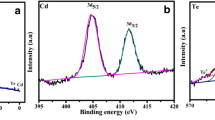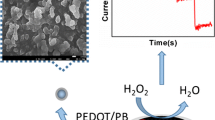Abstract
We have developed a simple procedure to evaluate the power of antioxidants. It is based on the detection of DNA damage by using an electrochemical biosensor. The latter was fabricated by immobilization DNA on a glassy carbon electrode. DNA damage is caused by the generation of hydroxy radicals in the ionic liquid 1-butyl-3-methylimidazolium hexafluorophosphate via a Fenton-type reaction. The ionic liquid provides a benign environment for the investigation of the free radicals. The effect of antioxidants on the oxidative damage of DNA can be monitored by the indicator Co(bpy) 3+3 , which binds to the intact DNA much more strongly than to damaged DNA. Ascorbic acid, rutin and aloe-emodin exhibited an inhibitory effect on the damage, and their antioxidative mechanisms were studied. It is also found that catalase displays a protective function against DNA damage by decomposing hydrogen peroxide.

Schematic diagram of DNA damage and antioxidative capacity




Similar content being viewed by others
References
Wattanapitayakul SK, Bauer JA (2001) oxidative pathways in cardiovascular disease: roles, mechanisms, and therapeutic implications. Pharmacol Ther 89:187–206
Mark JL (1987) Role of Alzheimer’s protein is tangled. Science 4:1352–1353
Schärer OD (2003) Chemistry and biology of DNA repair. Angew Chem Int Ed 42:2946–2974
Mello LD, Hernandez S, Marrazza G, Mascini M, Kubota LT (2006) Investigations of the antioxidant properties of plant extracts using a DNA-electrochemical biosensor. Biosens Bioelectron 21:1374–1382
Sigman DS (1990) Chemical nucleases. Biochemistry 29:9097–9105
Møller P, Loft S (2006) Dietary antioxidants and beneficial effect on oxidatively damaged DNA. Free Radical Bio Med 41:388–415
Frei B (1999) Molecular and biological mechanism of antioxidant action. FASEB J 13:963–964
Pietta PG (2000) Flavonoids as antioxidants. J Nat Prod 63:1035–1042
Bučková M, Labuda J, Šandula J, Križková L, Štĕpánek I, Ďuračková Z (2002) Detection of damage to DNA and antioxidative activity of yeast polysaccharides at the DNA-modified screen-printed electrode. Talanta 56:939–947
Halliwell B, Gutteridge J (2003) Free Radicals in Biology and Medicine. Oxford Science Publications University Press, Oxford
Huang D, Ou B, Prior RL (2005) the chemistry behind antioxidant capacity assays. J Agric Food Chem 53:1841–1856
Le Bourvellec C, Hauchard D, Darchen A, Burgot J, Abasq M (2008) Validation of a new method using the reactivity of electrogenerated superoxide radical in the antioxidant capacity determination of flavonoids. Talanta 75:1098–1103
Yang J, Zhang Z, Rusling JF (2002) Detection of Chemically-Induced Damage in Layered DNA Films with Co(bpy) 3+3 by Square Wave Voltammetry. Electroanal 14:1494–1500
Wei MY, Guo LH, Famouri P (2011) DNA biosensors based on metallo-intercalator probes and electrocatalytic amplification. Microchim Acta 172:247–260
Rusling JF (2004) Sensors for toxicity of chemicals and oxidative stress based on electrochemical catalytic DNA oxidation. Biosens Bioelectron 20:1022–1028
Qian P, Ai S, Yin H, Li J (2010) Evaluation of DNA damage and antioxidant capacity of sericin by a DNA electrochemical biosensor based on dendrimer-encapsulated Au-Pd/chitosan composite. Microchim Acta 168:347–354
Labuda J, Buckova M, Heilerova L, Silhar S, Stepanek I (2003) Evaluation of the redox properties and anti/pro-oxidant effects of selected flavonoids by means of a DNA-based electrochemical biosensor. Anal Bioanal Chem 376:168–173
Liu J, Roussel C, Lagger G, Tacchini P, Girault HH (2005) Antioxidant Sensors Based on DNA-Modified Electrodes. Anal Chem 77:7687–7694
Barroso MF, de-los-Santos-Álvarez N, Lobo-Castañón MJ, Miranda-Ordierea AJ, Delerue-Matos C, Oliveira MBPP, Tuñón-Blanco P (2011) DNA-based biosensor for the electrocatalytic determination of antioxidant capacity in beverages. Biosens Bioelectron 26:2396–2401
Silvester DS, He W, Aldous L, Hardacre C, Compoton RG (2008) Electrochemical Reduction of Benzoic Acid and Substituted Benzoic Acids in Some Room Temperature Ionic Liquids. J Phys Chem C 112:12966–12973
Buzzeo MC, Klymenko OV, Wadhawan JD, Hardacre C, Seddon KR, Compton RG (2003) Voltammetry of Oxygen in the Room-Temperature Ionic Liquids 1-Ethyl-3-methylimidazolium Bis((trifluoromethyl)sulfonyl)imide and Hexyltriethylammonium Bis((trifluoromethyl)sulfonyl)imide: One-Electron Reduction To Form Superoxide. Steady-State and Transient Behavior in the Same Cyclic Voltammogram Resulting from Widely Different Diffusion Coefficients of Oxygen and Superoxide. J Phys Chem A 107:8872–8878
Strehmel V, Laschewsky A, Wetzel H, Görnitz E (2006) Free Radical Polymerization of n-Butyl Methacrylate in Ionic Liquids. Marcromolecules 39:923–930
Pang DW, Abruña HD (1998) Micromethod for the investigation of the interactions between DNA and redox-active molecules. Anal Chem 70:3162–3169
Shutava TG, Kommireddy DS, Lvov YM (2006) Layer-by-layer enzyme/polyelectrolyte films as a functional protective barrier in oxidizing media. J Am Chem Soc 128:9926–9934
Lewandowski A, Galiński M (2004) Carbon–ionic liquid double-layer capacitors. J Phys Chem Solids 65:281–286
Laszlo JA, Compton DL (2001) α-Chymotrypsin catalysis in imidazolium-based ionic liquids. Biotechnol Bioeng 75:181–186
Prieto-Simón B, Cortina M, Campàs M, Calas-Blanchard C (2008) Electrochemical biosensors as a tool for antioxidant capacity assessment. Sens Actuators B 129:459–466
Mugweru A, Rusling J (2006) Studies of DNA Damage Inhibition by Dietary Antioxidants Using Metallopolyion/DNA Sensors. Electroanal 18:327–332
Arosio B, Gagliano N, Fusaro LMP, Parmeggiani L, Tagliabue J et al (2000) Aloe-Emodin quinone pretreatment reduces acute liver injury induced by carbon tetrachloride. Pharmacol Toxicol 87:229–233
Carr A, Frei B (1999) Does vitamin C act as a pro-oxidant under physiological conditions? FASEB J 13:1007–1024
Tian B, Hua YJ (2005) Concentration-dependence of prooxidant and antioxidant effects aloin and aloe emodin on DNA. Food Chem 91:413–418
Yang J, Guo J, Yuan J (2008) In vitro antioxidant properties of rutin. LWT 41:1060–1066
Jia S, Liang M, Guo L (2008) Photoelectrochemical Detection of Oxidative DNA Damage Induced by Fenton Reaction with Low Concentration and DNA-Associated Fe2+. J Phys Chem B 112:4461–4464
Diopan V, Babula P, Shestivska V, Adam V, Zemlicka M, Dvorska M, Hubalek J, Trnkova L, Havel L, Kizek R (2008) Electrochemical and spectrometric study of antioxidant activity of pomiferin, isopomiferin, osajin and catalposide. J Pharm Biomed Anal 48:127–133
Larson RA (1988) The antioxidants of higher plants. Photochem 27:969–978
Ohnishi S, Murata M, Oikawa S et al (2001) Oxidative DNA damage by an N-hydroxy metabolite of the mutagenic compound formed from norhaman and aniline. Mutat Res 494:63–72
Aronovitch Y, Godinger D, Israeli A et al (2007) Dual activity of nitroxides as pro- and antioxidants: catalysis of copper-mediated DNA breakage and H2O2 simulation. Free Radical Biol Med 42:1317–1325
Acknowledgements
This work was supported by the National Natural Science Foundation of China (No. 20875023) and the Foundation for Innovative Research Groups of the Education Department of Hubei Province (No. T201101).
Author information
Authors and Affiliations
Corresponding author
Rights and permissions
About this article
Cite this article
Xiong, H., Wang, Y., Zhang, X. et al. Evaluation of antioxidative capacity via measurement of the damage of DNA using an electrochemical biosensor and an ionic liquid solvent. Microchim Acta 176, 479–484 (2012). https://doi.org/10.1007/s00604-011-0739-4
Received:
Accepted:
Published:
Issue Date:
DOI: https://doi.org/10.1007/s00604-011-0739-4




